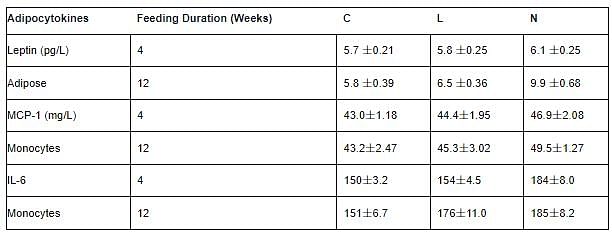Test: Biology - 6 - MCAT MCQ
15 Questions MCQ Test - Test: Biology - 6
Q. In SCID, which components of the adaptive immune response are affected?
Passage 1: Severe combined immunodeficiency disease (SCID) is the most severe form of inherited immunodeficiencies, characterized by various genetic defects. Although the disease affects both the B cell and T cell arms of the adaptive immune response, the specific genetic defects can vary among individuals. Without treatment, children with SCID typically succumb to opportunistic infections within their first year of life. Bone marrow transplant is a potential life-saving procedure for SCID patients, as it has the ability to reconstitute the patient's immune system by introducing healthy hematopoietic stem cells from a donor.
Passage 2: T-cells of the immune system can recognize carbohydrates present on the surface of bacterial cells and red blood cells. Interestingly, these carbohydrate similarities between cells can have implications for survival. For instance, individuals with blood type O are found to be more vulnerable to Vibrio infections, which are caused by Gram-negative bacteria and lead to cholera. On the other hand, individuals with blood types A or B are more susceptible to infections from a wide range of E. coli variants, also Gram-negative bacteria.
Q. How is SCID typically treated to improve chances of survival?
Passage 1: Severe combined immunodeficiency disease (SCID) is the most severe form of inherited immunodeficiencies, characterized by various genetic defects. Although the disease affects both the B cell and T cell arms of the adaptive immune response, the specific genetic defects can vary among individuals. Without treatment, children with SCID typically succumb to opportunistic infections within their first year of life. Bone marrow transplant is a potential life-saving procedure for SCID patients, as it has the ability to reconstitute the patient's immune system by introducing healthy hematopoietic stem cells from a donor.
Passage 2: T-cells of the immune system can recognize carbohydrates present on the surface of bacterial cells and red blood cells. Interestingly, these carbohydrate similarities between cells can have implications for survival. For instance, individuals with blood type O are found to be more vulnerable to Vibrio infections, which are caused by Gram-negative bacteria and lead to cholera. On the other hand, individuals with blood types A or B are more susceptible to infections from a wide range of E. coli variants, also Gram-negative bacteria.
| 1 Crore+ students have signed up on EduRev. Have you? Download the App |
Q. Which type of cells are responsible for reconstituting the immune system in a bone marrow transplant?
Passage 1: Severe combined immunodeficiency disease (SCID) is the most severe form of inherited immunodeficiencies, characterized by various genetic defects. Although the disease affects both the B cell and T cell arms of the adaptive immune response, the specific genetic defects can vary among individuals. Without treatment, children with SCID typically succumb to opportunistic infections within their first year of life. Bone marrow transplant is a potential life-saving procedure for SCID patients, as it has the ability to reconstitute the patient's immune system by introducing healthy hematopoietic stem cells from a donor.
Passage 2: T-cells of the immune system can recognize carbohydrates present on the surface of bacterial cells and red blood cells. Interestingly, these carbohydrate similarities between cells can have implications for survival. For instance, individuals with blood type O are found to be more vulnerable to Vibrio infections, which are caused by Gram-negative bacteria and lead to cholera. On the other hand, individuals with blood types A or B are more susceptible to infections from a wide range of E. coli variants, also Gram-negative bacteria.
Q. What is the primary cause of death in untreated children with SCID?
Passage 1: Severe combined immunodeficiency disease (SCID) is the most severe form of inherited immunodeficiencies, characterized by various genetic defects. Although the disease affects both the B cell and T cell arms of the adaptive immune response, the specific genetic defects can vary among individuals. Without treatment, children with SCID typically succumb to opportunistic infections within their first year of life. Bone marrow transplant is a potential life-saving procedure for SCID patients, as it has the ability to reconstitute the patient's immune system by introducing healthy hematopoietic stem cells from a donor.
Passage 2: T-cells of the immune system can recognize carbohydrates present on the surface of bacterial cells and red blood cells. Interestingly, these carbohydrate similarities between cells can have implications for survival. For instance, individuals with blood type O are found to be more vulnerable to Vibrio infections, which are caused by Gram-negative bacteria and lead to cholera. On the other hand, individuals with blood types A or B are more susceptible to infections from a wide range of E. coli variants, also Gram-negative bacteria.
Q. What conclusions can you draw from the attached graph?
A simple calculation of the rate of spread of a pox virus (virion) led researchers at Imperial College London to a new insight. Virions communicate with other virions. The researchers observed that the radius of an approximately circular plaque of infected cells grew to 1.45 mm in just 3 days. They measured the distance between adjacent cells to be 0.037 mm to obtain the apparent time for the lytic cycle (from infection to lysis). They compared this time to the actual rate at which new virions are formed: 5 to 6 hours.
To account for this discrepancy between observed and predicted growth rates, the researchers examined the viral entry process and discovered that the actin protein on the host cell’s surface that provided the viral receptor was modified by attachment. They then found a mutant virus that did not modify the cell surface protein. The dependence of the growth of plaque radius on time for the wild type and mutant are shown in the graph.
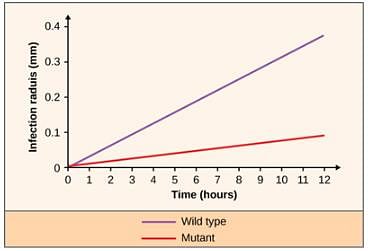
Q. According to the attached graph, how long does it take for the mutant virions infection radius to get to 0.1 mm?
A simple calculation of the rate of spread of a pox virus (virion) led researchers at Imperial College London to a new insight. Virions communicate with other virions. The researchers observed that the radius of an approximately circular plaque of infected cells grew to 1.45 mm in just 3 days. They measured the distance between adjacent cells to be 0.037 mm to obtain the apparent time for the lytic cycle (from infection to lysis). They compared this time to the actual rate at which new virions are formed: 5 to 6 hours.
To account for this discrepancy between observed and predicted growth rates, the researchers examined the viral entry process and discovered that the actin protein on the host cell’s surface that provided the viral receptor was modified by attachment. They then found a mutant virus that did not modify the cell surface protein. The dependence of the growth of plaque radius on time for the wild type and mutant are shown in the graph.
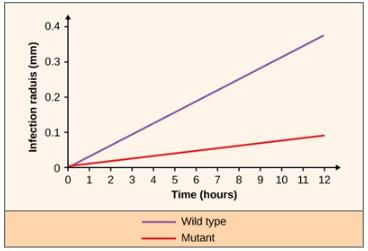
Q. According to the attached graph, how long does it take for the wild type virions infection radius to get to 0.2 mm?
A simple calculation of the rate of spread of a pox virus (virion) led researchers at Imperial College London to a new insight. Virions communicate with other virions. The researchers observed that the radius of an approximately circular plaque of infected cells grew to 1.45 mm in just 3 days. They measured the distance between adjacent cells to be 0.037 mm to obtain the apparent time for the lytic cycle (from infection to lysis). They compared this time to the actual rate at which new virions are formed: 5 to 6 hours.
To account for this discrepancy between observed and predicted growth rates, the researchers examined the viral entry process and discovered that the actin protein on the host cell’s surface that provided the viral receptor was modified by attachment. They then found a mutant virus that did not modify the cell surface protein. The dependence of the growth of plaque radius on time for the wild type and mutant are shown in the graph.
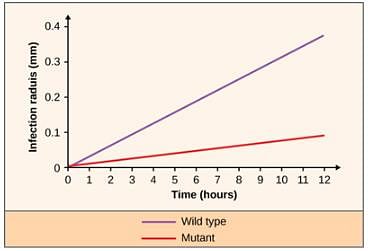
Q. What occurs during the lytic cycle of a virus? (You may consult the attached reference.)
A simple calculation of the rate of spread of a pox virus (virion) led researchers at Imperial College London to a new insight. Virions communicate with other virions. The researchers observed that the radius of an approximately circular plaque of infected cells grew to 1.45 mm in just 3 days. They measured the distance between adjacent cells to be 0.037 mm to obtain the apparent time for the lytic cycle (from infection to lysis). They compared this time to the actual rate at which new virions are formed: 5 to 6 hours.
To account for this discrepancy between observed and predicted growth rates, the researchers examined the viral entry process and discovered that the actin protein on the host cell’s surface that provided the viral receptor was modified by attachment. They then found a mutant virus that did not modify the cell surface protein. The dependence of the growth of plaque radius on time for the wild type and mutant are shown in the graph.
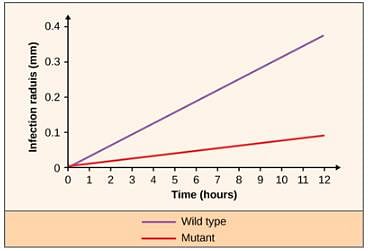
Q. The researchers found that the virions used actin proteins as a cellular receptor. What role do actin proteins play in the cell? (You may consult the attached reference.)
A simple calculation of the rate of spread of a pox virus (virion) led researchers at Imperial College London to a new insight. Virions communicate with other virions. The researchers observed that the radius of an approximately circular plaque of infected cells grew to 1.45 mm in just 3 days. They measured the distance between adjacent cells to be 0.037 mm to obtain the apparent time for the lytic cycle (from infection to lysis). They compared this time to the actual rate at which new virions are formed: 5 to 6 hours.
To account for this discrepancy between observed and predicted growth rates, the researchers examined the viral entry process and discovered that the actin protein on the host cell’s surface that provided the viral receptor was modified by attachment. They then found a mutant virus that did not modify the cell surface protein. The dependence of the growth of plaque radius on time for the wild type and mutant are shown in the graph.
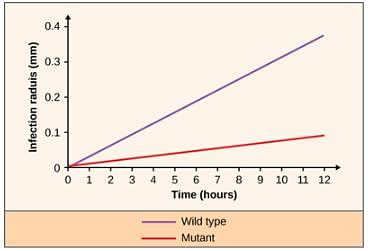
Q. Viruses have very simple structures, but all viruses are covered in a protective layer of proteins called a ____. (You may consult the attached reference.)
A simple calculation of the rate of spread of a pox virus (virion) led researchers at Imperial College London to a new insight. Virions communicate with other virions. The researchers observed that the radius of an approximately circular plaque of infected cells grew to 1.45 mm in just 3 days. They measured the distance between adjacent cells to be 0.037 mm to obtain the apparent time for the lytic cycle (from infection to lysis). They compared this time to the actual rate at which new virions are formed: 5 to 6 hours.
To account for this discrepancy between observed and predicted growth rates, the researchers examined the viral entry process and discovered that the actin protein on the host cell’s surface that provided the viral receptor was modified by attachment. They then found a mutant virus that did not modify the cell surface protein. The dependence of the growth of plaque radius on time for the wild type and mutant are shown in the graph.
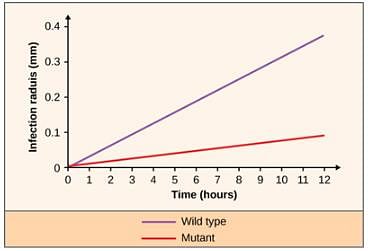
Q. Which general conclusion can you draw from the research results presented in the attached chart?
Water and the energy-yielding nutrients are also referred to as macronutrients because the body needs them in large amounts. In contrast, micronutrients are vitamins and minerals. These elements and compounds participate in many essential chemical reactions and processes, such as nerve impulses, and some, such as calcium, also contribute to the body’s structure. Your body can store some of the micronutrients in its tissues, and draw on those reserves if you fail to consume them in your diet for a few days or weeks. Some other micronutrients, such as vitamin C and most of the B vitamins, are water-soluble and cannot be stored, so you need to consume them every day or two.
Vitamin B12 is a co-enzyme involved in a wide variety of cellular processes. Synthesis of vitamin B12 occurs only in bacteria; in animals, these bacteria populate anaerobic environments in the gut. Consequently, vegan diets in developing nations and diets common to developing nations provide no source of B12 . Researchers (Ghosh et al. http://dx.doi.org/10.3389/fnut.2016.00001) found that rats whose diets contained limited (L) and no (N) B12 displayed symptoms that were not observed in the control group (C) whose diet included B12 and was otherwise identical. Chemical analysis of adipocytokines in the plasma after feeding periods of 4 and 12 weeks are shown in the following table. Over the 12 weeks of feeding, the weights of all three groups were equivalent, while the percent of body fat increased relative to the control for the rats fed a diet of limited and no B12: 40% (N) and 20% (L), respectively.
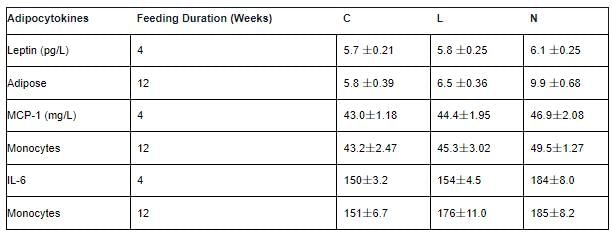
Q. According to the information in the attached chart, which of the adipocytokines showed an increase when compared to the control group after four weeks of treatment with B12?
Water and the energy-yielding nutrients are also referred to as macronutrients because the body needs them in large amounts. In contrast, micronutrients are vitamins and minerals. These elements and compounds participate in many essential chemical reactions and processes, such as nerve impulses, and some, such as calcium, also contribute to the body’s structure. Your body can store some of the micronutrients in its tissues, and draw on those reserves if you fail to consume them in your diet for a few days or weeks. Some other micronutrients, such as vitamin C and most of the B vitamins, are water-soluble and cannot be stored, so you need to consume them every day or two.
Vitamin B12 is a co-enzyme involved in a wide variety of cellular processes. Synthesis of vitamin B12 occurs only in bacteria; in animals, these bacteria populate anaerobic environments in the gut. Consequently, vegan diets in developing nations and diets common to developing nations provide no source of B12 . Researchers (Ghosh et al. http://dx.doi.org/10.3389/fnut.2016.00001) found that rats whose diets contained limited (L) and no (N) B12 displayed symptoms that were not observed in the control group (C) whose diet included B12 and was otherwise identical. Chemical analysis of adipocytokines in the plasma after feeding periods of 4 and 12 weeks are shown in the following table. Over the 12 weeks of feeding, the weights of all three groups were equivalent, while the percent of body fat increased relative to the control for the rats fed a diet of limited and no B12: 40% (N) and 20% (L), respectively.

Q. Monocytes and IL-6 play a role in what system in the human body? (You may consult the attached passage.)
Water and the energy-yielding nutrients are also referred to as macronutrients because the body needs them in large amounts. In contrast, micronutrients are vitamins and minerals. These elements and compounds participate in many essential chemical reactions and processes, such as nerve impulses, and some, such as calcium, also contribute to the body’s structure. Your body can store some of the micronutrients in its tissues, and draw on those reserves if you fail to consume them in your diet for a few days or weeks. Some other micronutrients, such as vitamin C and most of the B vitamins, are water-soluble and cannot be stored, so you need to consume them every day or two.
Vitamin B12 is a co-enzyme involved in a wide variety of cellular processes. Synthesis of vitamin B12 occurs only in bacteria; in animals, these bacteria populate anaerobic environments in the gut. Consequently, vegan diets in developing nations and diets common to developing nations provide no source of B12 . Researchers (Ghosh et al. http://dx.doi.org/10.3389/fnut.2016.00001) found that rats whose diets contained limited (L) and no (N) B12 displayed symptoms that were not observed in the control group (C) whose diet included B12 and was otherwise identical. Chemical analysis of adipocytokines in the plasma after feeding periods of 4 and 12 weeks are shown in the following table. Over the 12 weeks of feeding, the weights of all three groups were equivalent, while the percent of body fat increased relative to the control for the rats fed a diet of limited and no B12: 40% (N) and 20% (L), respectively.
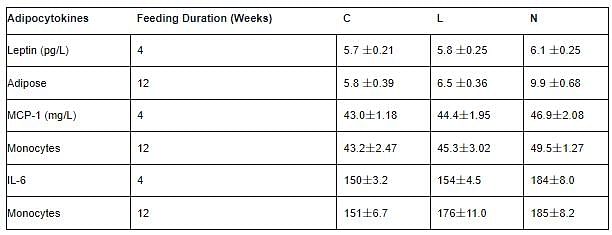
Q. Which type of cell makes the adipocytokine leptin? (You may consult the attached passage.)
Water and the energy-yielding nutrients are also referred to as macronutrients because the body needs them in large amounts. In contrast, micronutrients are vitamins and minerals. These elements and compounds participate in many essential chemical reactions and processes, such as nerve impulses, and some, such as calcium, also contribute to the body’s structure. Your body can store some of the micronutrients in its tissues, and draw on those reserves if you fail to consume them in your diet for a few days or weeks. Some other micronutrients, such as vitamin C and most of the B vitamins, are water-soluble and cannot be stored, so you need to consume them every day or two.
Vitamin B12 is a co-enzyme involved in a wide variety of cellular processes. Synthesis of vitamin B12 occurs only in bacteria; in animals, these bacteria populate anaerobic environments in the gut. Consequently, vegan diets in developing nations and diets common to developing nations provide no source of B12 . Researchers (Ghosh et al. http://dx.doi.org/10.3389/fnut.2016.00001) found that rats whose diets contained limited (L) and no (N) B12 displayed symptoms that were not observed in the control group (C) whose diet included B12 and was otherwise identical. Chemical analysis of adipocytokines in the plasma after feeding periods of 4 and 12 weeks are shown in the following table. Over the 12 weeks of feeding, the weights of all three groups were equivalent, while the percent of body fat increased relative to the control for the rats fed a diet of limited and no B12: 40% (N) and 20% (L), respectively.
